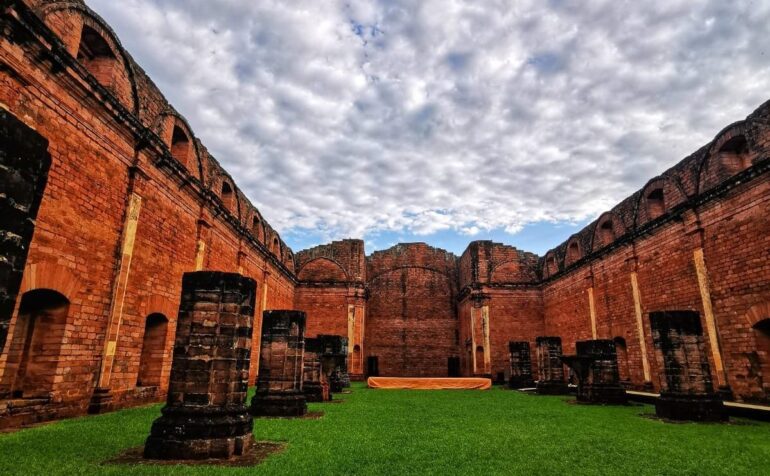The mission of “San Cosme y San Damián”, erected in the 18th century by the Jesuits in the department of Itapúa, seeks to be included in the UNESCO World Heritage list and thus keep alive a history in which indigenous beliefs were mixed with the scientific and religious beliefs of astronomer Buenaventura Suárez.
The mission is named after Cosme and Damián, two brothers and doctors who were later made Saints. Located on the banks of the Paraná River, it is a neighbor of the missions of Santísima Trinidad de Paraná and Jesús de Tavarangüé, which were declared World Heritage Sites in 1993. Its history dates back to 1632, the year in which it was established in the Sierra del Tapé (Brazil), but it was not until 1760 when it settled in the current town of San Cosme y Damián.
“San Cosme is one of the 30 towns founded by the Society of Jesus, where Jesuit priests worked with the Guaraní more than 300 years ago,” said Lucas Vázquez, one of the guides at the site, referring to the settlements built in what now corresponds to Argentina, Bolivia, Brazil, Chile, Paraguay and Uruguay, dubbed the “Thirty Towns.”
A joint effort to reach UNESCO World Heritage status
The Minister of the National Secretariat of Tourism (Senatur) of Paraguay, Angie Duarte, said that they hope to continue positioning this “unique Jesuit legacy, which is the pride of all Paraguayans,” with the incorporation of San Cosme and San Damián to the UNESCO list. “We are working with the Senatur team, together with other institutions, to achieve this nomination,” she said.
Duarte stressed that obtaining this recognition would represent a “great commitment to the conservation of these sites” and an incentive for tourism to Paraguay, which although “is not a beach destination,” is “an interesting place to discover.”
San Cosme y San Damián: A Paraguayan national treasure
Itapúa is home to three Jesuit missions: Santísima Trinidad de Paraná, Jesús de Tavarangüé and San Cosme y Damián, which are must-see destinations for visitors. Santísima Trinidad de Paraná, built in 1706 in Uruguay and moved to Paraguay in 1712, contains the remains of an urban centre on eight hectares. Its main church is an architectural gem for its baroque decorations and stone elements.
Also in Itapúa is the mission of Jesús de Tavarangüé, whose enormous temple is considered a replica of the Roman church of Loyola but was never completed due to the expulsion of the Jesuits.
A Temple, a school, and a clock

Smaller in size, San Cosme y San Damián has a better-preserved infrastructure, particularly its church, which houses the main parish of this town. Built with stones and wood from the area, the temple, 65.50 metres long and 12 metres wide, maintains much of its original structure, although it has undergone various reconstructions.
This reduction includes two-story halls, used in its time as a cloister and school, as well as vestiges of a kitchen and even an aqueduct. But what really makes this town special is the legacy of Buenaventura Suárez, a priest born in Santa Fe de la Veracruz (now Argentina).
The person in charge of this Jesuit mission at Senatur, Mariela Cantero, said that this site “was the first astronomical center in all of South America,” established by Suárez with the support of the Guaraní, with whom he made telescopes from tacuaras or bamboo, with quartz stones obtained mainly from the Paraná River.
Suárez installed a telescope in the church bell tower. He recorded his observations in the ‘Lunario de un siglo’, which he published for the first time in 1744 with forecasts of the lunar phases for the next 100 years. He also produced the first map of the area and left for posterity a sundial that accurately indicates the time in winter.
Today, Suárez’s knowledge and the Guaraní beliefs are part of the tourist attraction of the mission of San Cosme y San Damián, where guides such as Katterin Leguiza recall in their stories that almost 300 years ago a man in a cassock scanned the sky, while the natives planned their harvest or interpreted their reality according to the stars.
Today, Paraguayans look to the stars as an inspiration to explore the universe, with one Paraguayan company recently launching a pre-incubation program for entrepreneurs running start-up companies focused on space. Hopefully UNESCO will help preserve the monuments that document the journey of the star-gazing Guaraní peoples!



